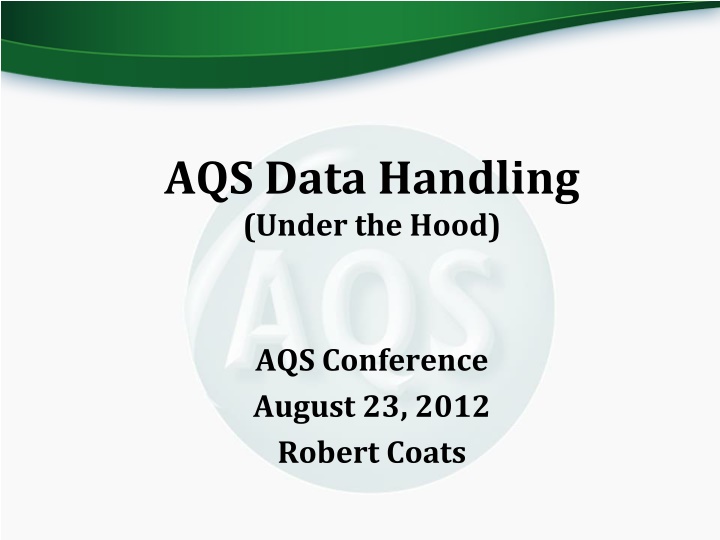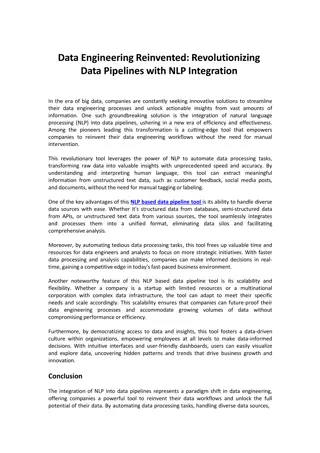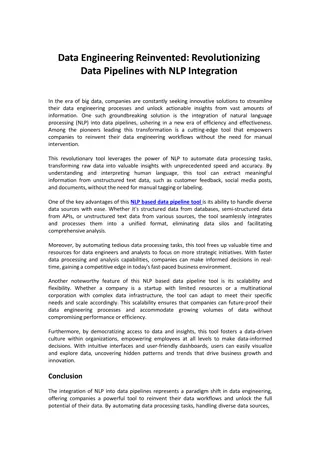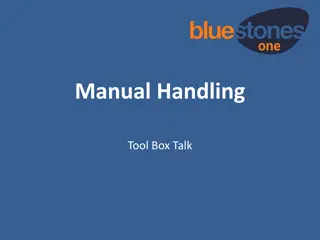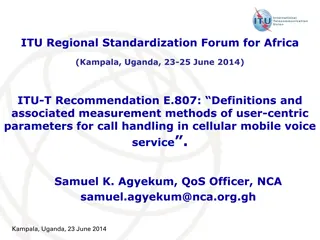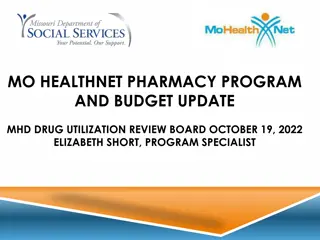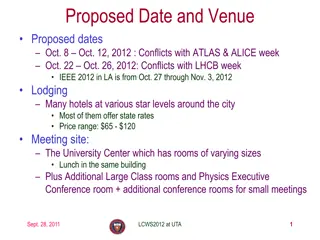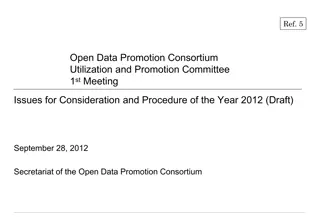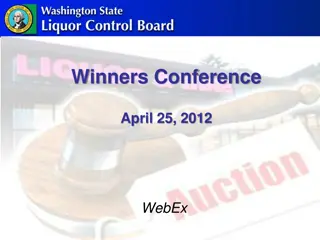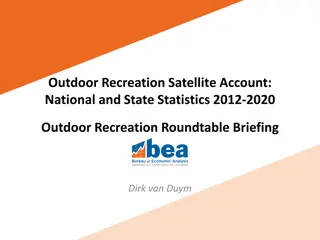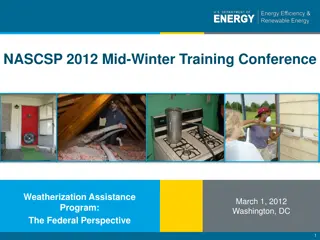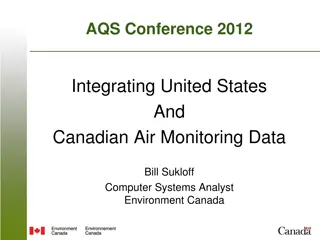AQS Data Handling: Insights from AQS Conference August 2012
Delve into the intricacies of AQS data handling discussed at the AQS Conference in August 2012. Explore topics such as sample measurement rules, MDL substitution, rounding methods, acceptance/rejection criteria, standard value calculation, and more. Gain insights into the importance of data completeness, qualifiers, and the one-half MDL substitution approach in air quality monitoring.
Download Presentation

Please find below an Image/Link to download the presentation.
The content on the website is provided AS IS for your information and personal use only. It may not be sold, licensed, or shared on other websites without obtaining consent from the author.If you encounter any issues during the download, it is possible that the publisher has removed the file from their server.
You are allowed to download the files provided on this website for personal or commercial use, subject to the condition that they are used lawfully. All files are the property of their respective owners.
The content on the website is provided AS IS for your information and personal use only. It may not be sold, licensed, or shared on other websites without obtaining consent from the author.
E N D
Presentation Transcript
AQS Data Handling (Under the Hood) AQS Conference August 23, 2012 Robert Coats
Topics Sample measurement acceptance/rejection rules MDL Substitution Rounding and truncating Allowed and disallowed qualifiers Summary statistics pollutant standards and exceptional data types Collection frequency Data completeness AQS Conference Providence, Rhode Island 2
Standard Value Calculation Process AQS Conference Providence, Rhode Island 3
Acceptance / Rejection Rules for Raw Data Site-Monitor configuration: Monitor exists and is active, monitor ownership, and etc. Valid protocol: Combination of (parameter, method, unit, duration, collection frequency) No duplicates Value between absolute min and absolute max for method AQS Conference Providence, Rhode Island 4
One-Half MDL Substitution The default behavior for AQS is to perform MDL substitution As of this writing, there are 85 parameters where MDL substitution does not occur. They are listed at http://www.epa.gov/ttn/airs/airsaqs/manuals/codedescs.htm under the name parameters_nomdlsub.xls. If an alternate MDL is provided on the RD transaction, it is used instead of the Federal MDL for the Methodology The AQS Team has been directed to reverse the present configuration, so that no MDL substitution is the default. AQS Conference Providence, Rhode Island 5
Rounding and Truncating AQS allows values to be reported with up to 5 digits after the decimal as Raw Data. AQS calculates a value in Standard Units for the parameter The number of digits after the decimal is specified by the summary scale for the method Rounding or truncating is specified for the parameter. Depending on the parameter, AQS may compute a multi- hour rolling or block average (rounded or truncated). AQS computes daily, quarterly, and annual statistics from the Standard Value or above average (not rounded or truncated). The statistic (e.g., annual mean) used for comparison to the NAAQS standard is rounded or truncated as per 40 CFR Part 50. AQS Conference Providence, Rhode Island 6
Allowed and Disallowed Qualifiers AQS maintains a table of qualifiers that are allowed for each parameter (posted at http://www.epa.gov/ttn/airs/airsaqs/manuals/codedescs.htm) For Regulatory parameters, the OAQPS monitoring staff have explicitly specified qualifiers that should be disallowed by parameter For non-regulatory parameters, qualifiers allowed on request subject to approval by the OAQPS monitoring staff. (i.e., many are presently configured to be allowed, but not all. New ones can be requested (email AQSTeam@epa.gov) AQS Conference Providence, Rhode Island 7
Summaries and Pollutant Standards (1) Each criteria pollutant has a set of NAAQS standards: Lead: 3-Month Rolling Average, Quarterly Standard (old) CO: 8-Hour Standard, and 1-Hour Standard SO2: 1-Hour Standard, Annual Standard, 24-Hour Standard, Secondary 3-Hour Standard, PM 10: 24-Hour Standard PM 2.5: 24-hour Standard, Annual Standard NO2: 1-Hour Standard, Annual Standard Ozone: 8-Hour 2008, 8-Hour 1997, 1-Hour Standard For each standard, separate summary records are computed at each time period (daily, annual, etc.) Caveat: Only summaries that make sense are computed. See: http://www.epa.gov/ttn/airs/airsaqs/manuals/pollutant_summaries.xls AQS Conference Providence, Rhode Island 8
Summary Statistics Exceptional Data Types For each summary, a record is created for each Exceptional Data type: 0: No Flagged Data 1: All Flagged values excluded from statistics 2: Nothing excluded from statistics (i.e. ignore flags) 5: Exclude regionally concurred exceptional event flags The net effect of the combination of Pollutant Standards and Exceptional Data types, is that there may be many records for a given summary period (e.g., Annual Summary) AQS Conference Providence, Rhode Island 9
Collection Frequency Collection frequency shows up in two places in AQS At the Monitor level as Required Collection Frequency , and for Raw Data as the Collection Frequency Code on the RD transaction. The Collection Frequency Code from the RD transaction is deprecated; it is not used for any processing in AQS. All completeness calculations, for other than hourly data, are controlled by the Monitor Required Collection Frequency. AQS Conference Providence, Rhode Island 10
Data Completeness Annual data completeness for criteria pollutants is determined as specified by 40 CFR Part 50. For non-criteria pollutants with daily duration (or a longer time period), it is determined using the Monitor Required Collection Frequency (RCF). In the past, there have been issues with the AQS Data Completeness Report, AMP430, for non- criteria pollutants. A change is in progress to this report, so that its results will exactly agree with the annual summaries for those pollutants. AQS Conference Providence, Rhode Island 11
Questions? AQS Conference Providence, Rhode Island 12
